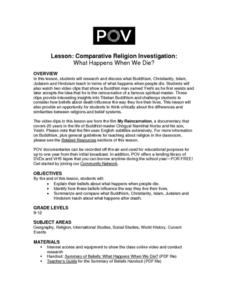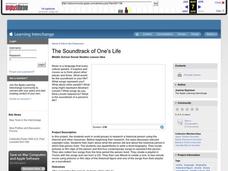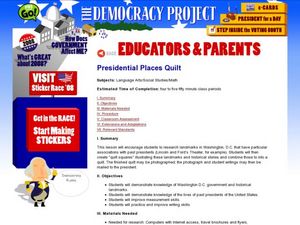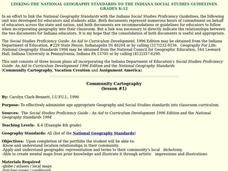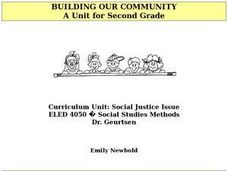American Documentary
Comparative Religion Investigation: What Happens When We Die?
How do different religions offer explanations for what happens when we die? Invite your learners to consider the variance and complexity of religious beliefs, and to research and compare/contrast the concept of death and afterlife...
National Endowment for the Humanities
La Familia
Young scholars identify at least one country where the Spanish language is spoken, describe similarities and differences between Spanish, Mexican, and Puerto Rican families, and practice speaking the Spanish words for several family...
Curated OER
French and Family
Where is France? Interest young learners in exploring France, French language, and French culture. They identify similarities and differences between French and American families, speak the French words for family members, analyze maps,...
Curated OER
Oh, What A Day
Students listen as the teacher reads A Country Far Away. They predict what they will do and what they think their partner student will be doing. Students create a KWL chart for Japan. They collect information about their activities on an...
Curated OER
Radio Program Disc 1, Track 6
Students place the Ohio river in its historical and geographical context. They listen to the radio stories, and are asked what postive and negative influences does the Ohio River have on nearby communities>
Curated OER
The Soundtrack of One's Life
Students gather important information about a historical figure. They write a short biography, including illustrations. Students collect songs from the time period when the person lived. They create a play list in iTunes. Students...
Curated OER
Presidential Places Quilt
Students design historical quilts. In this presidential history lesson plan, students research past presidents and landmarks named for them. Students create quilt squares to represent the landmarks and piece all of them together in a...
Orange County Water Atlas
Location, Location, Location…
Young geographers discover not only how to read and recognize coordinates on a map, but also gain a deeper understanding of latitude and longitude and how climate changes can vary significantly across latitudes.
Curated OER
The Lines of Perception
Here are four engaging lessons that focus on visual art, but also bring in elements of science and social studies. Learners view artwork, locate focal points, and visit and research community sites. They conduct internet research, and...
Curated OER
City, County, Community
Students explore issues and situations that make for a city and its local environments. In this local government activity, students design maps, define issues and create brochures that illustrate their understandings of these concepts...
Curated OER
Community Cartography
Students use an inflatable globe which they wrap in plastic wrap. They use a permanent marker and outline the continents, and label major oceans and trace the equator. Students bring heir globes and use their projection for a discussion...
Curated OER
A Toast to Our Community
Young scholars bake bread with a dual purpose: to explore, through the metaphor of baking bread, the potential dynamics and purposes of a classroom, and to begin investigating the idea that everyday things are connected to the...
Curated OER
Neighborhood and Community
Students research the history of North Logan, Utah. Using photographs, they identify the similiarties and differences between the past and today. They locate their home on a large map discuss ways in which different groups and...
Curated OER
Community Role Models in the Classroom: The Vietnam Era
Students research information about the Viet Nam Era. They listen to a guest speaker talk about his/her role in the Viet Nam War. Students write articles for the classroom newsletter or other appropriate publication.
Curated OER
Building Our Community
Second graders examine the different relationships within communities. They discover the need for rules and organization. They identify their role in the local community as well.
Curated OER
It Takes a Community
Third graders examine their own city governments. They investigate the rights and responsibilities of individuals as well as government services in their town. Students invite members of the governing body to speak to the class.


